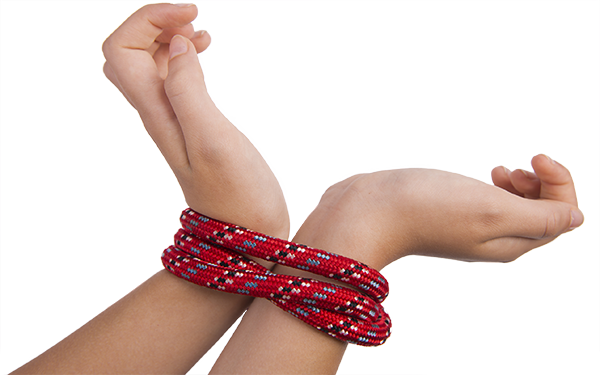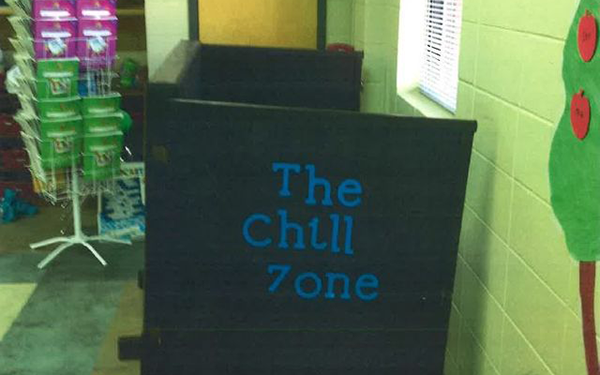Mississippi’s Horrifying Trend of Punishing Students Through Restraint Could Be Coming to an End

EDlection 2016 is The Seventy Four's ongoing coverage of state-level education news, issues and leaders in the run up to 2016 elections. (Among our previous stories in this series, stories from Iowa, Connecticut, Minnesota, Nevada, Ohio and Texas. See the latest stories here). The Mississippi primaries are scheduled for March 8.
What happens next — what sort of discipline is meted out, how long it lasts, and whether administrators or parents are notified — may differ drastically from one state to the next.
That’s because while all educators struggle with how to cope with defiant or disruptive kids, there is no federal legislation and only a patchwork of state laws regulating how two of the most fraught responses — restraint and seclusion — are used against them. As a result, restraint and seclusion are misapplied on millions of American schoolchildren each year, sometimes with deadly consequence.
Mississippi is one of five states without a policy governing restraint and seclusion in schools — but in a group that also includes New Jersey and North Dakota, it could be the next one to set a baseline for how these interventions should be handled.
If a policy prevails in Mississippi, it would put the state in line with new federal guidance in the recently reauthorized Every Student Succeeds Act (formerly known as No Child Left Behind). The new law will require states to develop plans on how they’ll reduce the use of restraint and seclusion, as well as bullying, harassment and student suspensions.
Ron Hager, a senior staff attorney at the National Disability Rights Network, called the ESSA language “a kind of foot in the door” toward ultimately doing away with restraint and seclusion altogether.
For the time being, though, Mississippi is a far cry from that scenario.
“They do whatever they want to do, whenever they want to do it, however they want to do it,” said Heather Rhodes, the mother of the boy who was secluded in the pen. She intends to file a civil case against the Lamar County school district, while a criminal complaint she filed against the teacher was dismissed in 2014.

Rhodes said she entered the classroom to find her son, Cade, who was 8 at the time, confined in a three-sided wooden pen, banging his head on the floor, screaming to get out and calling for her as his teacher held the gate closed with her foot.
Cade also has central auditory processing disorder (CAPD), which impairs his ability to listen and communicate back what’s been said or done. His teacher wanted him to sit down, but he knew his mother was on her way to his classroom with birthday treats for his classmates and wanted to find her, according to an investigative story by the Mississippi Clarion-Ledger.
The Clarion-Ledger reported: “The school dismissed the incident as no big deal, Rhodes said, but she was furious. “If I had that contraption in my house,” Rhodes said, “and my child told his teachers, 'My mom puts me in a box when I'm bad,' I would have been arrested and my kids would have gone to foster care.”
State by state, an effort to regulate these tactics and better protect students from potential abuse in their classrooms has slowly gained traction in the last six years, following a gut-wrenching 2009 report on restraint by the U.S. Government Accountability Office. The collected testimony from schools around the country included the case of a 14-year-old boy in Texas who died after being pinned down by a teacher; another involved a volunteer teacher’s aide in Florida who gagged and duct-taped 6- and 7-year-old students who were misbehaving.
Often in these cases, the GAO found, children with disabilities were forcibly restrained or isolated when they were not physically aggressive, and by staff who were not trained in these techniques.
Even in states with policies, there’s no guarantee that the adults in charge are aware or will heed them.
Take the recent case of the Kentucky sheriff’s deputy who, in a viral video, is shown handcuffing an 8-year-old boy’s biceps together behind his back — his wrists apparently too small for the cuffs — because he had misbehaved. The boy has attention deficit hyperactive disorder and post-traumatic stress disorder, but the officer wasn’t properly trained to discipline elementary students, much less those with disabilities, according to an ACLU complaint. This, in spite of Kentucky’s policy that explicitly prohibits mechanical restraints. (Read our investigation into school safety officers: “Armed but Untrained: Why So Many School Cops are Unprepared for the Classroom”)
The GAO report and subsequent criticism of the practice by former U.S. Education Secretary Arne Duncan led to several attempts to pass federal legislation that ultimately failed.
“As education leaders, our first responsibility should be to make sure that schools foster learning in a safe environment for all of our children and teachers,” Duncan wrote in a letter to state education officials in 2009, urging them to take action.
A federal bill sponsored in 2013 by U.S. Rep. Gregg Harper, a Republican congressman from Mississippi, would have established minimum standards for the practice of restraint and seclusion, as well as guidelines for state reporting and enforcement. It also stalled.
Meanwhile, in the last few years, 25 states have either strengthened existing laws or adopted them for the first time, according to an analysis called “How Safe is the Schoolhouse?” an Autism National Committee report by Jessica Butler, an attorney and parent advocate.
In addition to Mississippi, New Jersey and North Dakota, the states that remain without any law, policy or guidelines are Idaho and South Dakota, according to Butler’s report, last updated in July 2015.
Nationwide, far more often than not, the subjects of restraint and seclusion are children of color and children with disabilities. That’s evident in Mississippi, according to 2009 data from the Office of Civil Rights. Of the total 715 incidents of restraint and seclusion reported by schools that year, 72 percent involved black or Hispanic students while 28 percent involved white students.
Mississippi, however, is one of three outlier states where fewer than half of students subjected to physical restraint were students with disabilities, according to the Office of Civil Rights’ 2011 school discipline data snapshot. Whether that’s because students with special needs are under-classified is unclear.
L. Rene´ Hardwick grew up in Vicksburg, Miss., and returned to Jackson several years ago after working as a university professor and administrator and a K-12 consultant and advocate in places like Atlanta, Durham and Baltimore.
Now the advocacy coordinator for the restraint and seclusion project run by the Mississippi American Civil Liberties Union, she said there are cultural and historical factors at work here that influence attitudes toward behavior management and classroom discipline. Those factors are at least partially rooted in Mississippi’s painful history of segregation.
“What’s going on in Mississippi and particularly Jackson … is simply a microcosm of the legacy of oppression that hovers over Mississippi as a state and us as a country,” she said.
“I believe you have certain groups, some of whom are our legislators, who are dedicated and determined to support” the status quo of white supremacy, either out of fear or ignorance, she said.
Now in Mississippi, when a child doesn’t follow the teacher’s instructions, “you don’t know where that case will lead,” Hardwick said.
Hardwick said that if a child is being disruptive or fails to obey a teacher’s request, the “natural propensity of school personnel” in Mississippi is to respond with any tactics at their disposal.
Their propensity is not, she said, “to teach that child and guide that child, which takes time and needs to be repeated over and over to correct behavior.”
“That’s a process and if you don’t subscribe to that process philosophically, on a basic level, then you’re going to deal with children in the classroom in a way that’s convenient for you,” she said.
Many of Mississippi’s 490,225 students arrive at school from family environments strained by poverty and neglect, so it’s imperative that educators are prepared to meet them at the doors, Hardwick said. That means presenting school as a place of refuge, nurturing interpersonal relationships between adults and children, setting high expectations for teachers and parents, and, in the classroom, rooting curriculum in students’ real-life experiences.
Ensuring staff receive better training to prevent and respond to crisis situations involving children with disabilities and those in the general population is also badly needed, she said.
“What we’re pushing for is the tone of the policy to not be in reactive mode but to be in proactive mode,” Hardwick said, meaning it should promote a “climate of positive intervention” that starts at the top with effective district- and building-level leadership.
That’s a lot of ground to cover in one state education policy, but advocates feel they’re finally being heard by policymakers. At the same time, they maintain legislation is also necessary and hope to pursue that this year.
Some Mississippi schools have tried to address the problem of disruptive students on their own.
In 2012, an alternative school for children who’d been suspended or expelled from other schools agreed to stop shackling students to fixed objects after the Southern Poverty Law Center sued Jackson Public Schools in 2011. The SPLC alleged that students were "handcuffed and shackled to poles" for up to six hours for non-criminal offenses such as violating the dress code or talking back to a teacher, Reuters reported.
The lead plaintiff in the case was an eighth-grader with a history of attention deficit hyperactivity disorder, asthma and seizures who, on one occasion, was handcuffed to a pole for hours and had to call out to be taken to the bathroom, according to Reuters.
Advocate groups in Mississippi say requiring training for school personnel and prioritizing positive behavioral interventions ahead of force — all part of the current proposal being considered by state officials — will help avoid chaotic and potentially dangerous incidents like the ones in Jackson and Lamar County.
Groups including the ACLU and Families As Allies are pushing the state school board to craft a policy that clearly defines what kind of restraints can be used, by whom, and for what duration. It also spells out requirements for parent notification and districts’ internal record-keeping.
In fits and starts, legislators have moved to enact minimum standards for use of restraint and seclusion in Mississippi schools. But a tendency by the Republican majority to fiercely oppose limiting school districts’ local authority has stymied those efforts.
Skeptics of regulating restraint and seclusion frequently point to the education dilemma that’s caused anguish for teachers everywhere: How to preserve the learning environment for the many that is threatened by the few?
Republican Rep. John Moore, who is the most recent chairman of the House Education Committee, said he’d consider a restraint and seclusion bill if one is reintroduced this year, but he is “wary” of placing limits on school districts’ ability to control students if they become violent.
“If you are a teacher or a school and you have a child that will just not be quiet or sit down, what do you do with that student? Do you let them just destroy the education for the rest of the class? Or do you do what needs to be done?” Moore said.
Moore, who’s spent 20 years in the House of Representatives; four of those as education chairman, said he grew up in an era when a call from the principal to his mother or father meant he was in for a spanking when he got home. Moore’s wife is a veteran elementary school teacher.
He said he supports the use of restraint and seclusion in schools if and when “positive reinforcement” strategies have been tried and are ineffective.
“People have to learn that there are consequences of bad actions and if they don’t, it only elevates down the road,” Moore said, “And if you don’t believe me, just look at our prison systems.”
The education department’s proposed policy would dramatically redefine the threshold for using physical restraint in Mississippi classrooms: If approved by the nine-member state Board of Education, restraint and seclusion could only be used as an emergency response when “all other verbal de-escalation measures have failed” and when the student poses a danger to themselves or others.
It could also be used if there’s potential or actual destruction of property; and to remove a “non-compliant” student from the scene of an incident, according to the seven-page draft policy.
The policy bans “chemical restraints,” such as sedatives, and prohibits mechanical restraints like straps, harnesses and handcuffs. It also prohibits any restraint that obstructs the airway.
It’s the second time around for Mississippi education policymakers. In 2009, a task force convened by the state Board of Education developed some language but no action was taken.
The new policy was crafted with advocates’ input in 2015 following the failure of a related bill, the Student Safety Act, in March, which was sponsored by Republican Sen. Gray Tollison. It passed in the state Senate but never came to a vote in the House. Tollison, chairman of the Senate Education Committee, did not return messages seeking comment.
The Mississippi School Boards Association and state teachers and administrators associations have quietly resisted attempts to regulate restraint and seclusion, advocates say. The school boards group also skipped the opportunity to take a public stance on the proposed restraint and seclusion policy at two public hearings last year.
MSBA Executive Director Mike Waldrop and other school boards association employees did not respond to multiple requests for comment.
Pat Ross, the education department’s chief performance officer, said there’s no question about the need to have a policy. One of the major sticking points is whether the new rules would prohibit seclusion altogether, as the ACLU and other advocates groups have pushed for.
“Nobody likes for things to go badly in schools but sometimes they do and so restraint and seclusion has to come into play,” Ross said. “The schools in the districts across the state and, I think, across many states will tell you that — give us the parameters by which we can operate restraint and seclusion and we’ll do it within those parameters, but taking seclusion off the table completely maybe (is) a little unrealistic.”
Ron Hager, the National Disability Rights Network lawyer, was pushing for the new federal K-12 law to do away with restraint and seclusion.
“This is not what we had hoped for but it is something,” Hager said of the new ESSA rules. “It’s not an outright ban on restraint and seclusion but it requires that the states should take steps to reduce the use of those interventions. We would love to see (the U.S. Department of Education) issue more specific binding guidance and we think it’s the perfect time to do it because of the requirements of the ESSA.”
The Mississippi state education department met again with key advocates and stakeholders Wednesday, looking for input on a revised policy that will be presented to the Board of Education in mid-February. The board’s approval would kick off a 30-day public hearing period, and once that wraps up, the board would hold a final vote to adopt the policy as soon as this spring, Ross said.
Hardwick said she’s optimistic that state officials are finally, and sincerely, listening, as evidenced in the special Oct. 22 meeting advocates organized with Ross and other state officials prior to a public hearing.
“We have commitment from Pat Ross that a more diverse set of stakeholders will review the feedback and make a more earnest and sincere attempt to (develop a policy) that embraces positive interventions and supports,” Hardwick said. “(The state education department) has been very good about meeting us halfway.”
Rhodes, the parent whose son was secluded in the wooden pen known as the “Chill Zone” and later, in another district, locked in a closet during a fire drill, said she’s “trying to have faith” in the will of the department to enact meaningful change.
Parents’ voices need to continue being heard, Rhodes added, but it’s not easy for them to speak up. Some fear their children will be retaliated against in school if they complain; if they work in the schools themselves, they also risk retribution.
Too many other parents are simply disengaged, she said, and either lack the wherewithal to be involved in their children’s school lives or don’t care. Case in point: Each of the public hearings on the restraint and seclusion policy, held in Jackson with ample public notice, were attended by only a few dozen people.
Rhodes is a single parent to 9-year-old Cade and his twin sister, Calea and works part-time. She also regularly spends hours attending special education services meetings (for her own children and others) and talking to lawyers regarding Cade’s case. With a pre-law degree and a professional background in teaching and administration, she has enough savvy to navigate the education bureaucracy — and she’s become an unofficial representative for other parents of special needs students struggling with the system.
“I’m taking all that from my life experience and it’s become my life purpose,” Rhodes said. “These are kids that don’t have a voice. They don’t have someone standing up for them… If any good comes for any other child from fighting the battle for my children or through what my children have personally endured, it's all for a greater purpose.”
Get stories like these delivered straight to your inbox. Sign up for The 74 Newsletter

;)
